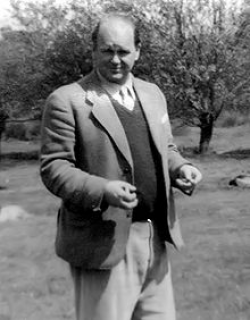Sir Peter Scott

Sir Peter Scott
- Born
- 14 September 1909
- Died
- 29 August 1989 (age 79)
Sir Peter Scott was successful in many areas; he was an Olympic yachtsman, a television presenter, a gliding champion, a painter and he held the Distinguished Service Cross for gallantry. He was also a passionate conservationist who helped to establish a number of today’s environmental institutions. He was the first conservationist to be knighted in 1973.
Scott's father was Scott of the Antarctic, who died there when the boy was just eighteen months old. In his dying letter, Captain Scott asked his mother to make the boy interested in natural history. In later life, Sir Peter fought to conserve the Antarctic from human exploitation and contributed to the signing of the Antarctic Treaty. This treaty established Antarctica as a scientific preserve, established freedom of scientific investigation and banned military activity there.
In 1946, he set up the Wildfowl and Wetlands Trust (WWT) at Slimbridge as a centre for science and conservation. In a unique move at the time, he opened it to the public so that everyone could get close to nature. There are now nine Wetland centres around the UK, and WWT undertakes research and conservation projects around the world.
the most influential conservationist of the twentieth century
World Wildlife Fund, 2014.
In 1962, the first nene (a species of goose) reared at Slimbridge was released into the wild in Hawaii. This marked the start of the world recovery of the nene population, which had fallen to thirty. There are now 2,000 nenes across the world.
In 1999 the long-term protection of barnacle geese at Caerlaverock enabled the Svalbard barnacle goose population to increase to 25,000, after dropping to 300 in 1948. In 2010, the Great Crane project saw the release of 21 Eurasian cranes into the wild; the species had been absent from the UK for 400 years.
Sir Peter helped to set up the World Conservation Union's (now IUCN) Red Data books in 1962, which record whether species are threatened or endangered. He was also a founder, along with Sir Julian Huxley, of the World Wildlife Fund (WWF) and became its first chairman. He used his artistic talents to design the WWF logo.
Sir Peter was a great communicator and presented a number of television programmes in the 1950s and 1960s. His series Look did much to introduce natural history to the British public. In 1968 he narrated The Private Life of the Kingfisher, the first BBC natural history programme to be shown in colour. Along with David Attenborough, he was decribed in a BBC TV series in 2004 as being largely responsible for the way that the British public, and much of the world, views wildlife.



